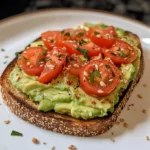Description of this recipe
This Mother’s Day Crab Cake Benedict is an elegant and decadent brunch dish perfect for celebrating the special women in your life. Imagine succulent, golden-brown crab cakes topped with perfectly poached eggs and a luscious, creamy hollandaise sauce. This dish is a symphony of flavors and textures that will tantalize your taste buds and leave you feeling utterly indulged. It’s a sophisticated twist on the classic Eggs Benedict, elevating the brunch experience to new heights.
Why you will love this recipe
You’ll fall in love with this Crab Cake Benedict for several reasons. First, it’s incredibly flavorful. The sweetness of the crab meat, the tanginess of the lemon juice, and the richness of the Parmesan cheese create a harmonious blend that is simply irresistible. The creamy hollandaise sauce adds a layer of velvety goodness, while the perfectly poached eggs provide a burst of runny yolk that enhances every bite.
Second, it’s surprisingly easy to make, especially when you break down the components into manageable steps. While it might seem intimidating at first, the recipe is designed to be straightforward, allowing you to create a restaurant-quality dish in the comfort of your own kitchen. The satisfaction of crafting such an exquisite meal is incredibly rewarding.
Finally, it’s a guaranteed crowd-pleaser. Whether you’re hosting a Mother’s Day brunch or simply want to treat yourself to a luxurious breakfast, this Crab Cake Benedict is sure to impress. It’s an unforgettable culinary experience that will leave everyone asking for seconds.
Ingredients:
Crab Cakes:
- 1 lb fresh lump crab meat, picked through for shells
- 2 large eggs (for poaching)
- ½ cup plain breadcrumbs, preferably panko for extra crispiness
- ¼ cup mayonnaise, preferably homemade or high-quality store-bought
- 1 tbsp lemon juice, freshly squeezed
- ¼ cup grated Parmesan cheese, finely grated
- 1 tsp paprika, sweet or smoked, depending on your preference
- 2 tbsp unsalted butter (for cooking)
- Salt and freshly ground black pepper to taste
Hollandaise Sauce:
- 3 large egg yolks
- ½ cup (1 stick) melted unsalted butter, clarified for best results
- 1 tbsp lemon juice, freshly squeezed
- Pinch of cayenne pepper (optional)
- Salt to taste
Optional Extras:
- English muffins, split and toasted
- Fresh chives, chopped for garnish
- Asparagus spears, blanched or roasted for a side dish
- Cherry tomatoes, halved for a fresh element
Preparation:
Step 1: Prepare the Crab Cakes
In a large bowl, gently combine the fresh lump crab meat, breadcrumbs, mayonnaise, lemon juice, Parmesan cheese, paprika, salt, and pepper. Be careful not to overmix, as you want to keep the crab meat in distinct lumps. Overmixing will result in tough crab cakes.
Step 2: Form the Crab Cakes
Divide the crab mixture into equal portions, typically about 6-8 patties, depending on your desired size. Gently form each portion into a round patty, pressing lightly to ensure they hold their shape. Place the formed crab cakes on a parchment-lined baking sheet.
Step 3: Chill the Crab Cakes
For extra crispiness and to prevent the crab cakes from falling apart during cooking, place the baking sheet in the refrigerator and chill the crab cakes for at least 30 minutes. This step allows the patties to firm up and retain their shape better when cooked.
Step 4: Cook the Crab Cakes
Preheat your oven to 400°F (200°C). While the oven is preheating, melt the butter in a large skillet over medium heat. Once the butter is melted and shimmering, carefully place the chilled crab cakes into the skillet, being careful not to overcrowd the pan. Cook for about 4-5 minutes per side, until the crab cakes are golden brown and heated through.
Step 5: Bake the Crab Cakes (Optional)
For an extra crispy exterior, transfer the skillet with the crab cakes to the preheated oven and bake for an additional 5-7 minutes, or until they are heated through and golden brown. If you prefer, you can skip this step and simply continue cooking the crab cakes in the skillet until they are done.
Step 6: Poach the Eggs
While the crab cakes are cooking, bring a saucepan of water to a gentle simmer. Add a splash of white vinegar to help the eggs coagulate. Crack each egg into a small bowl, then gently slide the egg into the simmering water. Poach the eggs for about 3-4 minutes, or until the whites are set but the yolks remain runny. Use a slotted spoon to remove the poached eggs from the water and place them on a paper towel-lined plate to drain.
Step 7: Prepare the Hollandaise Sauce
In a heatproof bowl, whisk together the egg yolks and lemon juice. Place the bowl over a saucepan of simmering water, making sure the bottom of the bowl doesn’t touch the water. Whisk constantly until the mixture thickens and becomes pale yellow. This should take about 3-5 minutes.
Step 8: Emulsify the Hollandaise Sauce
Slowly drizzle the melted, clarified butter into the egg yolk mixture, whisking constantly. It’s crucial to add the butter in a slow and steady stream to ensure the sauce emulsifies properly and doesn’t break. Continue whisking until the sauce is thick, creamy, and glossy. Season with a pinch of cayenne pepper (if using) and salt to taste.
Step 9: Assemble the Benedict
If using, toast the English muffins until golden brown. Place two crab cakes on each plate, then top with a perfectly poached egg. Generously drizzle the hollandaise sauce over the egg, allowing it to cascade down the sides of the crab cakes. Garnish with fresh chives and serve immediately.
COOKING Rating:
Medium
Serving Suggestions:
- Serve the Crab Cake Benedict immediately after assembling.
- Pair with a side of blanched asparagus spears or roasted cherry tomatoes.
- Offer a selection of fresh fruit, such as berries or melon, to complement the richness of the dish.
- Serve with a crisp glass of sparkling wine or a refreshing mimosa for the ultimate brunch experience.
Tips:
- Use the freshest lump crab meat available for the best flavor and texture.
- Be gentle when mixing the crab cake ingredients to avoid breaking up the crab meat.
- Chill the crab cakes before cooking to help them hold their shape and crisp up nicely.
- Use clarified butter for the hollandaise sauce to prevent it from breaking.
- Keep the hollandaise sauce warm by placing the bowl over a saucepan of warm water or in a thermos.
- If the hollandaise sauce becomes too thick, whisk in a tablespoon of warm water to thin it out.
- If the hollandaise sauce breaks, try whisking in a tablespoon of ice water to bring it back together.
- Don’t overcook the poached eggs, you want the yolk to be runny.
Prep Time:
25 minutes
Cook Time:
20 minutes
Total Time:
45 minutes
Nutritional Information:
(Estimate per serving, excluding optional extras)
Calories:
Approximately 650-750 calories
Protein:
Approximately 35-45 grams
Sodium:
Approximately 600-800 milligrams
Conclusion
This Mother’s Day Crab Cake Benedict is more than just a recipe; it’s an experience. It’s a celebration of flavor, texture, and the joy of creating something special for the people you love. From the succulent crab cakes to the perfectly poached eggs and the creamy hollandaise sauce, every element of this dish is designed to tantalize your taste buds and leave you feeling utterly satisfied. Whether you’re hosting a Mother’s Day brunch or simply want to treat yourself to a luxurious breakfast, this Crab Cake Benedict is sure to impress. So, gather your ingredients, put on your apron, and get ready to create a culinary masterpiece that will be remembered long after the last bite.
Questions and Answers about this recipe
Q1: Can I use canned crab meat instead of fresh lump crab meat?
A: While fresh lump crab meat is highly recommended for the best flavor and texture, you can use canned crab meat as a substitute. Be sure to drain the canned crab meat thoroughly and pick through it to remove any shell fragments. Keep in mind that canned crab meat may have a slightly different flavor and texture than fresh crab meat, but it can still work well in this recipe.
Q2: What if my hollandaise sauce breaks or becomes too thin?
A: Hollandaise sauce can be a bit tricky, but there are ways to fix it if it breaks or becomes too thin. If the sauce breaks (separates), try whisking in a tablespoon of ice water to bring it back together. If the sauce is too thin, continue whisking it over the simmering water until it thickens to your desired consistency. Just be careful not to overcook the sauce, as this can cause it to curdle.
Q3: Can I make the crab cakes ahead of time?
A: Yes, you can definitely make the crab cakes ahead of time. Form the patties, place them on a parchment-lined baking sheet, and store them in the refrigerator for up to 24 hours. This can be a great time-saver if you’re preparing for a brunch or special occasion. Just be sure to cook the crab cakes thoroughly when you’re ready to serve them.
Q4: Can I bake the crab cakes instead of cooking them in a skillet?
A: Yes, you can bake the crab cakes instead of cooking them in a skillet. Preheat your oven to 400°F (200°C), place the formed crab cakes on a parchment-lined baking sheet, and bake for about 15-20 minutes, or until they are golden brown and heated through. Baking the crab cakes is a healthier option and can be just as delicious.
Q5: What can I serve with this Crab Cake Benedict to make it a complete meal?
A: This Crab Cake Benedict is delicious on its own, but you can serve it with a variety of sides to make it a complete meal. Some great options include blanched asparagus spears, roasted cherry tomatoes, a fresh fruit salad, or a side of crispy breakfast potatoes. A light green salad with a vinaigrette dressing can also be a refreshing complement to the richness of the dish.




